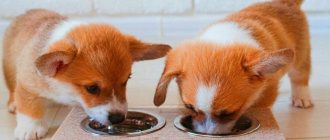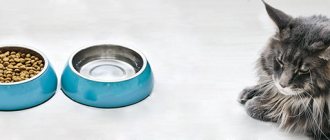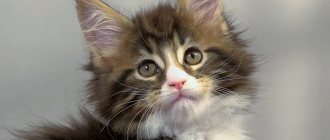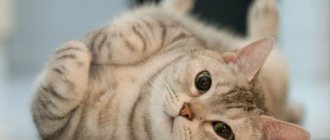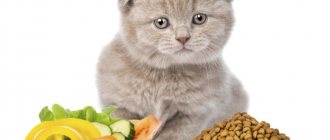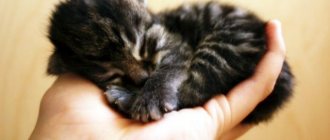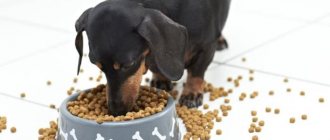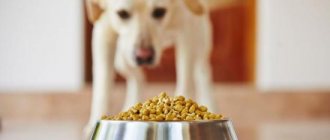8407Administration
At three months of age, kittens begin to feed completely on their own; they enter an important period in their lives. This time is characterized by the active growth of the baby, teeth begin to change and the skeleton and muscle mass actively develop. Therefore, owners need to know how to feed a kitten for 3 months, because the development and health of your pet depends on proper nutrition.
Most babies stop receiving milk from a cat at the age of 3 months. And the intensive development of a baby requires a lot of energy and vitamins . Organizing the correct feeding diet will help with this.
Pets get to their owners in different ways, based on this, it is necessary to approach the choice of products at the first stage of feeding babies.
- If a kitten came into the house from your cat and is growing before your eyes, from birth. In this case, there are practically no problems. It is enough to gradually transfer the baby to the type of food that you determine. In addition, he will be able to periodically receive milk from his mother, this will help change his diet without stress for the little body.
- When the pet is taken from friends or cat breeders, at the age of 3 months. With this option, it is necessary to clarify what kind of food the baby received and at first, when feeding, try to give mainly foods that are familiar to him. If you do not have enough knowledge in the field of keeping cats, it is better to get advice from specialists. For example, ask the former owners about the diet of a three-month-old kitten.
- If you pick up a baby you like on the street. First of all, he must be shown to an animal hospital, where, during examination, they will not only correctly determine his age, but can also identify possible diseases and recommend how to deal with them. From doctors in veterinary clinics, you can get recommendations on diet and feeding regimen.
© shutterstock
Features and rules of feeding
When feeding a kitten aged 3-4 months, you need to consider a number of important points:
- the smaller and more active the kitten, the greater the frequency of feeding;
- an undernourished pet will develop more slowly and get sick more often, a constantly overeating pet will suffer from obesity and other diseases;
- decide in advance on the choice of food for your pet: natural food or ready-made food for kittens;
- introduce new foods gradually, without offering everything at once and alternating feeding different foods (the kitten gradually gets used to a certain diet);
- you cannot put the entire daily portion in a bowl: the baby has not yet learned to control his appetite and may overeat, and after a while the hungry body will have nothing to support its growth and playful state;
- monitor the temperature of the food served to him: the food should be warm;
- do not forget to add minerals and vitamins to your food;
- the kitten should have a separate bowl for warm drinking water (the drink should be changed frequently so that it does not stagnate, and the bowl should be thoroughly washed to prevent oxidation; the pet should have unlimited access to water).
Feeding kittens without a cat
In the first days of life, mother's milk helps the kitten better adapt to new conditions. But it happens that babies are deprived of parental warmth early. You have to feed the kitten yourself. A special mixture that is sold in pet stores is suitable for this. It should be used to feed kittens in the first month after birth.
You cannot replace the mixture with cow's milk - it is permissible to use it only after a month, otherwise the kittens will develop diarrhea, and they may even die, because their stomachs are still very weak to digest complex food. It’s better to feed your baby goat’s milk for some time after using a mother’s milk substitute. This rule is relevant not only for purebred animals, but also for yard kittens.
For feeding, it is convenient to use a pipette or a bottle with a small nipple (all of this is also sold in pet stores). The second option is more preferable, since it is important to develop a sucking reflex in the baby. If it is not yet available, use a pipette to get a few drops of the mixture into the kitten's mouth, and then immediately apply it to the nipple - this way he will understand what needs to be done. In addition to the mixture, you can give the kitten warm water using a pipette or syringe.
Another option is to find a wet nurse. A cat that has recently given birth can feed a baby left without a mother.
Feeding regimen and norm
The total weight of portions eaten per day should be approximately 0.2 kg per 1 kg of weight (at a standard weight, kittens need 0.4 kg of food per day, i.e. the pet should eat 0.1 kg of food per meal) . A three-month-old kitten can get by with 180 grams, but a four-month-old kitten may not have enough for two hundred (with a weight of 3 kg - 0.6 kg per day). The appetite and ability to digest the amount of food offered will depend on many factors: the exact age, breed, activity, weight, and health of the pet.
Experts advise creating a varied diet for every day and setting a feeding schedule for your pets. Three-month-old kittens are recommended to be fed 5-6 times a day, and four-month-old kittens, if there are no problems, can be fed 4 times a day.
Basic rules for feeding a newborn kitten
If the formula option is not suitable, try preparing food for your baby from milk and yolk. The components are taken in a 4:1 ratio and blended in a blender. You will get a thick mixture that needs to be diluted with water. The resulting product can be fed to newborn kittens. Just remember that chicken eggs must be fresh.
1 month
After the baby is 3-4 weeks old, you can include new foods in his diet. For the first complementary feeding, it is better to use products similar in composition to breast milk. For example, this is meat puree for children. They do not complicate digestion and are pleasant to the taste. You need to start with 1 meal a day, gradually increasing meals with new foods.
2 months
The diet doesn't change much. You can try including dry food in your diet. In addition to purees, you need to give your kitten solid food. The food does not need to be ground or chopped - the animal can handle it quite well. As the kittens grow, they will eat more. You can add cottage cheese, greens, pumpkin, porridge, cabbage, and raw yolk to your diet. These foods will help dry food digest better and reduce the likelihood of constipation. At this age, animals cannot yet control portions, and you need to make sure that they do not overeat. The first time, foods should be given in small quantities so that the body gets used to the new regime.
3 months
This is the period when babies' teeth begin to change. For their normal growth, you should include more solid food in your diet. It is acceptable to feed the kitten raw meat, but this will require additional use of deworming medications. Small bones will also work. By this age, the dosage is already clear to the animal, and he begins to eat in accordance with his appetite.
It is acceptable to include vegetables, boiled fish, cottage cheese, milk porridge, and yoghurt in the menu. And if previously the pet ate 8-10 times a day, now you can simply arrange 3 full meals. If you get used to this gradually, when the kitten is left at home alone, he will not go hungry.
5 months and older
You can give your pet food for adult animals. It is permissible to sprout grass that the kitten will eat from the flowerpot - it will help the food to be digested normally.
Diet
Having chosen a certain method of nutrition, do not deviate from it, otherwise it will threaten unpredictable consequences for the baby’s fragile body. It is prohibited to combine two feeding methods - eating natural food and ready-made cat food.
Veterinarians explain this by saying:
- wards will have digestive problems leading to gastrointestinal diseases;
- An overdose of vitamins in an animal can lead to hypervitaminosis.
Natural nutrition
After the change of milk teeth, the diet of a growing 3-4 month old kitten must include solid food rich in protein. It is recommended to diversify dairy products whenever possible. Veterinarians also advise adding vegetables rich in various vitamins to your food. Meat components should be included in the pet's diet in overwhelming quantities, and cereals and vegetables can make up less than half of the daily portion of food. You can’t completely stop your kitten from eating meat: the taurine it contains is very important for heart and eye health.
It must be remembered that natural nutrition does not mean feeding the animal food from your table.
Veterinary experts advise including the following natural products in the diet of a 3-4 month old kitten:
- It is mandatory for the kitten to consume boiled lean meat - primarily beef, as well as chicken fillet or turkey meat in small chopped pieces or in the form of minced meat (if there is a confirmed absence of worms, from the age of three months it is also allowed to give raw frozen meat, tested for quality);
- low-fat milk and fermented milk products without additives - kefir, fermented baked milk, etc.;
- low-fat cottage cheese, necessary for strengthening teeth and bones (initially it is better to start by consuming a ready-made liquid product, for example, Agusha brand cottage cheese, which has proven itself well);
- various vegetables - pumpkin, zucchini, cabbage - in chopped form (raw grated ones are best, but if the kitten refuses to eat them in their pure form, you can mix vegetable mixtures into porridge or boil cereals in vegetable broth);
- raw or boiled and chopped egg yolk;
- lean fish without bones (preferably sea fish, because a river pet can easily become infected with worms);
- cereal dishes - porridge with water, milk, vegetable and meat broth (the cat's body accepts semolina and rice best);
- special grass that is useful for cats (you can grow it yourself on the windowsill, or buy sprouted oat or wheat sprouts at a pet store or veterinary pharmacy);
- vegetable oil in small quantities to improve digestion.
What should you not feed?
It is recommended to completely exclude a three-month-old kitten from the diet:
- fatty foods that will only harm the stomach and liver (in particular pork - meat, lard, fat);
- meat with bones (a kitten can choke on hollow bones or scratch the stomach walls);
- whole cow's milk;
- salted and spiced food (often, in an effort to make food more attractive, breeders rely on their own taste and make it completely unsuitable and dangerous for a small, fragile organism);
- spicy and canned food (sausages, canned food from your table);
- fried foods (can clog the intestines with toxins);
- tomatoes and eggplants;
- corn and cereals from it;
- any sweets, especially chocolate (eating them weakens the immune system, causes dental disease and hair loss).
It is better to limit the consumption of some foods to a minimum, these are:
- oat and bean cereals;
- River fish;
- potatoes in any form (cats are almost unable to digest starch).
During the period of illness, some foods are also excluded from the diet: for diarrhea - fermented milk, for constipation - solid foods containing carbohydrates and starch in the required amount. In addition, the “cat owner” needs to be very careful and keep vitamins and medicines intended for people out of the kitten’s reach, otherwise, if he tries them, he may get seriously poisoned.
How often and in what quantity per week you can give your pet basic foods is up to each owner to decide individually, but the main recommendations are as follows:
| Daily | Once every 2 days | in 7 days |
| beef (30-80 grams) | vegetable oil (0.5 tsp) | 3-4 times every 7 days: chicken fillet or minced meat: (50-120 grams) |
| milk and fermented milk products without fruit additives (100 grams each) | 2-3 times every 7 days: vegetable puree or porridge with added vegetables (20-30 grams of vegetables) | |
| 1-2 times every 7 days: raw chicken egg yolk (1 pc.) | ||
| cereals and cereals in porridges (100 grams) | ||
| low-fat sea fish (100 grams) | ||
| beef or chicken liver (50 grams) |
Depending on the exact age, weight and activity of the pet, these proportions can be reduced or increased by 5-15%.
Feeding tips
When using natural food, it is important that the food is always fresh. The only possible exception is kefir. Also consider the following rules:
- animals should not be given smoked meats and pickles (even if these are meat or fish products);
- food should be warm, but not scalding;
- After each meal you need to wash the bowl;
- pieces that are too coarse need to be chopped even for an adult animal.
Natural: basic rules
When feeding homemade food, do not teach the animal to eat from the table, do not feed it leftover food during lunch. The kitten must understand where its bowl is located, and that food for it is located only in this place. Otherwise, you risk getting a beggar who will also steal food from the table.
Don't forget about vitamins that are important for a growing body. We also already talked about sprouting weed. Instead, you can plant wheat, the sprouts of which kittens are also very fond of.
Food basket
For a pet, you should buy beef, not pork, which is too fatty for a fragile body. Chicken, turkey, and sea fish are suitable. The latter is also good because it does not contain helminths that the kitten can become infected with. However, you shouldn’t even give sea fish too often - it’s enough to include it in the diet 1-2 times a week. Canned fish is also allowed, but due to the high salt content and high fat content, it is better to mix them with cereals.
Not all cats drink milk. Moreover, an older kitten does not need it; it is better to replace it with fermented milk products. If the kitten refuses this product, experiment with kefir and yogurt without additives. Control the fat content level - it is better to choose 2.5% options. Low-fat products are also not suitable due to the high sugar content in the composition.
Kittens love yolk and cottage cheese puree, sour cream, porridge with pieces of meat or vegetables, broths and soups. Just make sure that they do not contain legumes - this product is difficult to digest.
Ready-made feed
Often a certain breed of cat requires the use of artificial food. This method is also chosen by owners who are too busy and cannot constantly prepare food for their pet. Ready-made food has one important advantage - it already contains as many vitamins and minerals as the animal requires for normal development. It is better to accustom an animal to solid food gradually, starting with canned food.
Bosch Sanabelle wet food
This option belongs to the premium class and comes from Germany. Among the advantages, it is worth highlighting the balanced composition, in which the majority is animal protein, as well as the absence of artificial ones. However, the downside is that this food contains cellulose and maize - kittens are often allergic to these components. Therefore, it would be right to buy a small amount of food and see how your pet reacts to it.
Hills – food for kittens
This is another premium food that often has counterfeits, so buy it only in trusted stores. Among the advantages is a rich complex of vitamins and minerals. However, a high percentage of carbohydrates that are poorly absorbed by a growing body, a large amount of vegetable protein and a high likelihood of developing allergies are important disadvantages. There is also quite a lot of liquid in the package.
ProPlan Junior
This premium food is affordable, and many owners choose it. The brand is presented in many stores, and purchasing such food is not a problem. One of the advantages is the presence of probiotics in the composition, many types. But the product contains a lot of preservatives and vegetable protein.
Ready-made feed
The opinions of veterinarians regarding which food to prefer - natural or ready-made specialized food - do not coincide. The main advantage of ready-made food is that there is no need to introduce special complementary foods, as with natural nutrition, since it already contains fortified supplements. But there is also a significant drawback - the addition of flavors and preservatives, which can harm the health of babies.
If you decide to feed your pet prepared food, you need to remember the rules:
- Do not mix dry and wet food together;
- stick to a particular brand of food and change it only if absolutely necessary.
When choosing ready-made food, you need to carefully study the products of manufacturing companies. Find out whether it is possible to use their food, combine dry and wet canned food, and in what quantity to give them. According to veterinarians’ recommendations, from four months onwards, a kitten can be given the entire daily portion at once: it already knows how to control the amount of food it eats. It is better to pour wet canned food in sauce and jelly in the quantity required for a single meal. In case of a possible combination, the daily diet of a pet, according to the recommendations of experts, should consist of 3 quarters of dry food and 1 quarter of canned food.
Therefore, it is better not to skimp on the health of your beloved furbabies. Brands such as Royal Canin, Acana, Purina, Nutro Choice have long established themselves on the Russian market. Among them there are both dry and wet canned food, which can be combined.
Without causing harm to the baby’s health, you can use the following foods:
Acana
One of the best proven super premium food series. It provides a complete balanced diet and is the best hypoallergenic food. The food is produced in its own juice. The composition includes only whole and fresh ingredients. It contains meat ingredients, vegetables, fruits, seaweed, fresh eggs, polyunsaturated fats, proteins and proteins in optimal quantities.
Royal Canin
Dry food from this company is the best substitute for natural food, as it contains the substances necessary to maintain the life and activity of a kitten. The brand’s “medicinal” line is especially popular. The composition of veterinary feeds from this company is ideally balanced and takes into account the characteristics of a particular disease. Suitable food for kittens aged 4-12 months.
Amount of water when feeding a kitten dry food
In order for the kitten’s body systems to function at a high level, along with the necessary substances, the minerals contained in the water must also be supplied.
Water, in itself, is not a source of energy, but is a special substance necessary for the passage of biochemical reactions, serves as a natural solvent, and takes part in the processes of respiration, blood circulation and, of course, digestion.
When your pet consumes dry food, the amount of drinking water should be unlimited. So, you should not force a cat to drink water, but there should always be access to water. Otherwise, there is a high risk of serious diseases associated with disruption of the urinary system. First of all, when there is a lack of fluid in the body, it is the kidney structures that suffer.
Features of kitten care
In general, kittens at 3-4 months should be kept the same as before. An important difference is that since, starting from 3 months, they eat meat and fish, this means they can be susceptible to infection with worms and various infections. Therefore, owners need to adhere to the vaccination schedule and deworm their pets on time.
With any diet - natural food or industrial food - you need to ensure that your pet has constant access to clean drinking water. After eating, give your pet time to relax and rest, and then play with him to maintain physical activity and health.
Features by breed
Depending on the breed of cat, there are some differences in the nutrition of kittens. Owners of British, fold-eared and hairless breeds should pay special attention to this.
Fold
The main feature when feeding such kittens is that they need food 6 times a day for up to 3 months. Since these babies have an increased tendency to diseases of the urinary system and joints, it is better for them to choose a super-premium industrial diet. It will contain everything you need, and will also exclude substances that may increase the risk of pathologies. The belief that high doses of calcium in the diet will cause a kitten's ears to stand up is erroneous.
British
Due to their rapid growth and dense build, representatives of the breed require food with high calorie content from childhood. Meat in their diet should make up 65% of the total volume. It is also worth remembering that if you often feed liver, kelp and carrots to a kitten with a special blue color, it will begin to change somewhat.
Hairless kitten
Bald
These kittens have a very sensitive digestive system and also have a high risk of obesity. Due to a predisposition to gaining excess weight, a baby of the Don Sphynx, Elf, Bambino, Dwelf, Minskin, Ukrainian Levkoy or Canadian Sphynx breeds must be fed in strictly dosed quantities, and his bowl must be removed at regular intervals so that food is not constantly available.
Also, due to the lack of fur, hairless breed cats require more calories to maintain the required body temperature than other cats. Because of this, meat in their diet is at least 65%, just like the British or Chinchillas. To maintain good skin condition, you should enrich your diet with B vitamins, zinc and polyunsaturated acids.
There are many difficulties, so we wrote a separate article about the nutrition of hairless cats. You can read it here.
Why do you need to determine the age of a kitten?
It is advisable to know the age of your pet, especially when it is picked up on the street. At least in order to get vaccinated in a timely manner or treat him with those drugs that are permissible and acceptable for him.
Animals that are younger than four to five months cannot be transported across the country’s border. Although this is due to the fact that after mandatory vaccinations against viral infections and rabies, a quarantine period of at least 30 days must pass.
Therefore, if a foreign breeder tries to sell a baby and claims that he is five months old, but he looks like three, you should doubt it and figure it out.
You can also come across scammers who sell small-sized adult animals under the guise of a purebred kitten in Russia. In this case, advice on how to determine the age of a kitten will definitely come in handy.
Homemade food or store-bought kitten food?
Arguing about which diet is best for a growing body is a thankless task. There will be plenty of supporters of feeding homemade food, as well as opponents. Both methods of eating have a number of advantages and disadvantages, for example, cooking at home will cost less than buying specialized food, but will the owner dare to cook every day? Those who advocate for home-cooked food are stopped by the price of store-bought quality food. What to feed small cats and cats is decided by each owner, based on his own ideas and income.
- Popular foods
- New
- Stock
Proplan for canned food for kittens CHICKEN
Proplan canned food for kittens CHICKEN High content of chicken Meat and meat by-products (of which 14% chicken), fish and fish by-products, minerals, components...
Price: from 73
Proplan pouch for kittens TURKEY in sauce
Proplan pouch for kittens TURKEY in gravy Specially designed tender pieces in gravy for kittens that are easy to chew; Thanks to the content of PUFAs (polyunsaturated fatty acids...
Price: from 56
Dry food for kittens PRO PLAN Junior
Dry food for kittens PRO PLAN Junior PRO PLAN® food contains a special combination of ingredients developed with the participation of scientists to maintain the health of kittens for…
Price: from 276
Dry food GO (Go) for kittens and cats with chicken, fruits and vegetables
Dry food GO (Go) for kittens and cats with chicken, fruits and vegetables
Price: from 1254
Brit Care Endurance for active dogs that use a lot of energy
Brit Care Endurance for active dogs that expend a lot of energy Hypoallergenic formula for older (over 7 years) dogs of all breeds. This is a perfectly balanced dry food from Brit with a high...
Price: from 454
Monge Cat BWild GRAIN FREE grain-free food made from cod, potatoes and lentils for adult cats
Monge Cat BWild GRAIN FREE grain-free cod, potato and lentil food for adult cats Monge Cat BWild GRAIN FREE grain-free cod, potato and lentil food for adult cats 1.5 kg. The emergence of the BWild feed line...
Price: from 1200
Monge Dog Specialty Mini food for adult dogs of small breeds lamb with rice and potatoes
Monge Dog Specialty Mini food for adult dogs of small breeds, lamb with rice and potatoes Monge Dog Specialty food for dogs of all breeds, lamb with rice and potatoes 2.5 g Complete food for adult dogs of small breeds…
Price: from 575
Royal Canin Hypoallergenic DR 25 Feline Dry dietary food for adult cats with food allergies
Royal Canin Hypoallergenic DR 25 Feline Dry dietary food for adult cats with food allergies Complete dry dietary food for adult catsDry food ROYAL CANIN® HYPOALLERGENIC (Hypoallergenic DR 25…
Price: from 611
Dr. Clauder's. Canned dog food with meat (800g).
Dr. Clauder's. Canned dog food with meat (800g). Dr. Clauder's Selected Meat - premium, natural and delicious meat for your dog. Inulin supplement stimulates growth...
Price: from 168
Alleva Holistic Ocean Fish, Hemp and Aloe Vera Puppy Mini for small breed puppies, pregnant and lactating bitches
Alleva Holistic Ocean Fish, Hemp and Aloe Vera Puppy Mini for small breed puppies, pregnant and lactating bitches Ingredients: dehydrated ocean fish (50%), fresh ocean fish (20%), sweet potato, fish oil, pea starch, root…
Price: from 935
TetraFauna Tortoise
TetraFauna Tortoise Balanced main food for land turtlesArticle: 149557 Manufacturer: TETRA (Germany) Pieces per pack: 1 • Balanced…
Price: from 380
Monge Dog Fresh canned dog food beef
Monge Dog Fresh canned food for dogs beef Monge Dog Fresh canned food for dogs beef 100 g Complete food for dogs. Beef pate. Feeding recommendations: for…
Price: from 70
ALL FOOD FOR KITTENS
Perhaps expert advice will help you find the right solution:
- Consider financial possibilities: it makes sense to switch to a home cooking method if good specialized nutrition is expensive.
- Buying cheap food simply means harming your small pet; The composition of ready-made food advertised on TV is distinguished by the abundance of vegetables, meat and bone meal, and the addition of flavoring additives that are so attractive to cats. An unhealthy composition will result in problems with health and well-being.
- Kitten food is an ideal solution if the owner works a lot, stays late, is tired and does not have the strength to prepare a delicious dinner for the baby; take out the bag and you're done.
- Natural products are undoubtedly healthier than store-bought cat food. When choosing a method of feeding homemade food, remember: you will have to prepare a variety of dishes to cover your pet’s daily need for microelements. Make up for the deficiency with vitamin supplements. This incurs certain financial costs, but the finished pates and granules are balanced, the composition has the necessary substances for growth and harmonious development.
- A diet based on meat and cereals is ideal for a growing body. Physiologically, the intestines of animals are adapted to process hard protein foods, so soft foods (pates) become a common cause of constipation and diarrhea.
Diet selection and menu planning
First of all, you need to decide what you are going to feed your pet - ready-made kitten food or natural food, since mixing them is not recommended. Or ready-made industrial rations - or natural food! The fact is that different foods are digested differently.
To digest natural food, you do not need additional water, while to digest dry food you need to drink plenty of water. If the type of food changes frequently, the gastrointestinal tract of the kitten’s fragile body may not have time to rebuild, and as a result, various digestive problems are possible.
It is also unacceptable to combine different types of food. This is fraught with the occurrence of digestive insufficiency and the intake of excess vitamins and minerals into the body.
Kitten food should be tasty
A reasonable compromise is the right decision of a caring owner. Feeding an animal only meat and offal is not the best solution. Experts recommend offering heart, liver, and lungs to your pet several times a week, replacing a meat dish. Proper nutrition requires variety; foods need to be mixed (for example, oatmeal with meat, vegetables and egg yolk).
Delicious food for your baby does not contain salt or spices. Before feeding, warm up cold food and cool hot food, take care of the animal. Provide your pet with a bowl of water and constantly check the contents and freshness.
Raw vegetables are not suitable for feeding small pets. Boil them and you will get a tasty dish suitable for the age of a small fluffy ball.
Have you decided to introduce a new product? Keep it in moderation, the first portion is very small, just introducing the kitten to a new taste.
Breastfeeding raises a lot of controversy. It is known that full-fat cow's milk often causes intestinal disorders. Experts advise purchasing special mixtures from veterinary stores. Goat's milk is a good option; it is easier for animals to accept.
Estimating a cat's age by behavior
If kittens are found on the street with their mother, then, first of all, you need to pay attention to how she feeds them.
The female begins to limit the babies' sucking at about six weeks, completely weaning them off the breast by about eight to ten weeks. But often the litter continues to suck, all the time it is next to her.
If the kitten is fully capable of eating on its own, then it is at least seven to eight weeks old. At this age, the baby begins to explore the world around him with pleasure.
You can also monitor your pet's gait. He makes his first attempts to walk at the age of about three weeks, and before that he only sucks, sleeps and crawls next to his mother and brothers or sisters.
If the kitten's gait is unsteady, then it is no more than three weeks old. By the age of one month, the baby can usually turn over in the air when falling and land on all four paws.
Most often, by one and a half months the pet is already running quite quickly and playing enthusiastically.
Until two or three weeks the kitten sees and hears poorly. But if he clearly reacts to movement and noise around him, then he is at least four weeks old.
By two months, the pet already has good reactions and excellent hearing, he confidently jumps and runs, is not afraid of others, and remembers the location of rooms and furniture. At the same time, the baby continues to joyfully explore the environment, finding new places for games and mischief.
